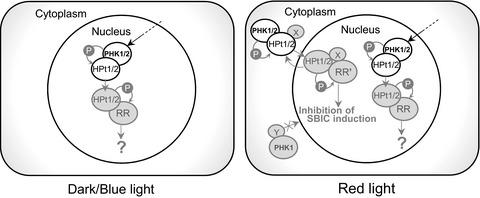当前位置:
X-MOL 学术
›
Genes Cells
›
论文详情
Our official English website, www.x-mol.net, welcomes your
feedback! (Note: you will need to create a separate account there.)
Red light-regulated interaction of Per-Arnt-Sim histidine kinases with partner histidine-containing phosphotransfer proteins in Physcomitrium patens
Genes to Cells ( IF 1.3 ) Pub Date : 2021-06-04 , DOI: 10.1111/gtc.12878 Shu Anami 1 , Takafumi Yamashino 2 , Ryo Suzuki 1 , Kota Nakai 1 , Kensuke Sato 1 , Bowen Wu 1 , Masashi Ryo 3 , Mamoru Sugita 1 , Setsuyuki Aoki 1
Genes to Cells ( IF 1.3 ) Pub Date : 2021-06-04 , DOI: 10.1111/gtc.12878 Shu Anami 1 , Takafumi Yamashino 2 , Ryo Suzuki 1 , Kota Nakai 1 , Kensuke Sato 1 , Bowen Wu 1 , Masashi Ryo 3 , Mamoru Sugita 1 , Setsuyuki Aoki 1
Affiliation

|
Multi-step phosphorelay (MSP) is a broadly distributed signaling system in organisms. In MSP, histidine kinases (HKs) receive various environmental signals and transmit them by autophosphorylation followed by phosphotransfer to partner histidine-containing phosphotransfer proteins (HPts). Previously, we reported that Per-Arnt-Sim (PAS) domain-containing HK1 (PHK1) and PHK2 of the moss Physcomitrium (Physcomitrella) patens repressed red light-induced protonema branching, a critical step in the moss life cycle. In plants, PHK homolog-encoding genes are conserved only in early-diverging lineages such as bryophytes and lycophytes. PHKs-mediated signaling machineries attract attention especially from an evolutionary viewpoint, but they remain uninvestigated. Here, we studied the P. patens PHKs focusing on their subcellular patterns of localization and interaction with HPts. Yeast two-hybrid analysis, a localization assay with a green fluorescent protein, and a bimolecular fluorescence complementation analysis together showed that PHKs are localized and interact with partner HPts mostly in the nucleus, as unprecedented features for plant HKs. Additionally, red light triggered the interactions between PHKs and HPts in the cytoplasm, and light co-repressed the expression of PHK1 and PHK2 as well as genes encoding their partner HPts. Our results emphasize the uniqueness of PHKs-mediated signaling machineries, and functional implications of this uniqueness are discussed.
中文翻译:

Per-Arnt-Sim 组氨酸激酶与 Physcomitrium patens 中含组氨酸的磷酸转移蛋白的红光调节相互作用
多步磷继电器 (MSP) 是生物体中广泛分布的信号系统。在 MSP 中,组氨酸激酶 (HKs) 接收各种环境信号并通过自磷酸化将它们传递,然后磷酸转移到含有组氨酸的磷酸转移蛋白 (HPts) 上。此前,我们报道了每ARNT-SIM(PAS)的苔藓HK1(PHK1)和PHK2结构域的Physcomitrium(叶剑)藓抑制红光诱导的原丝体分支,这是苔藓生命周期中的关键步骤。在植物中,PHK 同源编码基因仅在早期分化的谱系中保守,例如苔藓植物和石松植物。PHKs 介导的信号机制特别从进化的角度引起了人们的注意,但它们仍未得到研究。在这里,我们研究了P。专利PHK 专注于其亚细胞定位模式以及与 HPt 的相互作用。酵母双杂交分析、绿色荧光蛋白定位分析和双分子荧光互补分析共同表明,PHK 定位并与主要在细胞核中的伙伴 HPt 相互作用,这是植物 HKs 前所未有的特征。此外,红光触发细胞质中 PHKs 和 HPts 之间的相互作用,并且光共同抑制PHK1和PHK2以及编码它们的伙伴 HPts 的基因的表达。我们的结果强调了 PHKs 介导的信号机制的独特性,并讨论了这种独特性的功能含义。
更新日期:2021-06-04
中文翻译:

Per-Arnt-Sim 组氨酸激酶与 Physcomitrium patens 中含组氨酸的磷酸转移蛋白的红光调节相互作用
多步磷继电器 (MSP) 是生物体中广泛分布的信号系统。在 MSP 中,组氨酸激酶 (HKs) 接收各种环境信号并通过自磷酸化将它们传递,然后磷酸转移到含有组氨酸的磷酸转移蛋白 (HPts) 上。此前,我们报道了每ARNT-SIM(PAS)的苔藓HK1(PHK1)和PHK2结构域的Physcomitrium(叶剑)藓抑制红光诱导的原丝体分支,这是苔藓生命周期中的关键步骤。在植物中,PHK 同源编码基因仅在早期分化的谱系中保守,例如苔藓植物和石松植物。PHKs 介导的信号机制特别从进化的角度引起了人们的注意,但它们仍未得到研究。在这里,我们研究了P。专利PHK 专注于其亚细胞定位模式以及与 HPt 的相互作用。酵母双杂交分析、绿色荧光蛋白定位分析和双分子荧光互补分析共同表明,PHK 定位并与主要在细胞核中的伙伴 HPt 相互作用,这是植物 HKs 前所未有的特征。此外,红光触发细胞质中 PHKs 和 HPts 之间的相互作用,并且光共同抑制PHK1和PHK2以及编码它们的伙伴 HPts 的基因的表达。我们的结果强调了 PHKs 介导的信号机制的独特性,并讨论了这种独特性的功能含义。











































 京公网安备 11010802027423号
京公网安备 11010802027423号